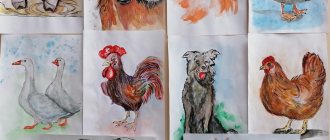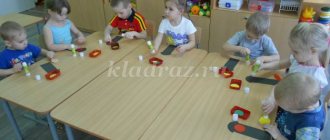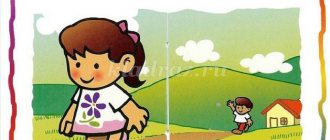Walks in the fall in the junior group of kindergarten. Notes
Autumn walk for children 2-4 years old “Affectionate Puppy Tishka” (“Kitten Vaska”)
Goal: to introduce children to the body parts of a puppy (kitten), their names;
clarify what the baby eats, how he eats (gnaws, laps), distinguish between vocal and motor reactions, the behavior of mother and son when they meet; enrich children's role-playing activities. Progress of the walk
The children go for a walk and start playing. You can look at a picture of puppies with your children. Then, after 20 minutes, the teacher quietly takes out the toy puppy and places it on the path of the site. The children notice him and are happy. The teacher clarifies: “I’ve come to visit,” takes him in his arms, and offers to pet him. The adult reminds how to stroke the baby. Everyone decides together who the puppy’s mother is. They examine his fur, name his body parts, and give him the name Tishka. “Affectionate, doesn’t growl at us! He knows we are kind people,” the kids say confidently.
The teacher reminds the children that guests are always treated. Everyone approaches the kitchen together and asks to give the puppy a treat. The cook brings out candy, milk and a piece of boiled meat. The teacher asks the children what to treat Tishka with. The children are silent. An adult comes to the rescue: “Now we’ll see what Tishka chooses!” Everyone thanks the cook, goes to the veranda and watches as the puppy ignores the candy, sniffs the milk and begins to eat the meat. "Sharp teeth! — the adult clarifies. “He’ll grow up a little and start gnawing on bones.” Then he laps up the milk.
When Tishka has eaten, the teacher suggests: “Let’s take the baby to the mother dog, otherwise she’s worried why the puppy is taking so long to come home.” Everyone goes to the dog, releases the puppy, watches how the mother dog caresses her son: licks him, washes him, combs him. “The puppy is small, he doesn’t know how to bark yet, he just whines with joy,” explains the adult. Everyone listens to the puppy whine.
Then the children return to the site. The teacher suggests: “Let's play. Who wants to be Tishka?”, enriches children’s role-playing actions with suggestions and clarifications. Children play independently, and at the end of the walk there is an outdoor game “Inflate, my balloon!”
Autumn walk in the younger group of the “Red Housewife” kindergarten
Goal : clarify the names: tree, bush; introduce children to the concepts: smooth, prickly, heavy, light, long, short, thick, thin; introduce the inhabitant of the forest - the squirrel.
Progress of the walk
The teacher says that today everyone will go to the forest (park). Children take buckets and baskets. At the edge of the forest, the teacher draws their attention to trees, bushes and shows the trunk, branches, leaves: “Trees have thin and thick trunks.”
Children begin to run around and shout: “Aw! We are lost in the forest!”, hiding behind a thick tree: “Ay! Look for us! We hid behind a tree."
Having run around, everyone gathers around the teacher, who offers to bring sticks, whichever one likes. Everyone looks at the sticks, older children, with the help of the teacher, count to two, determine: long or short, thick or thin, what the stick looks like.
If possible, the teacher draws the children’s attention to squirrels jumping on branches. If not, he immediately proceeds to displaying a soft toy, placing it low on the lower branches of the Christmas tree.
“Look, guys, someone is looking at us carefully from above,” says the teacher. - Who is this? Red, bushy tail! Of course, this is a squirrel - the mistress of the forest. Let’s say hello to her, reassure her: “We are kind people, we don’t offend any animals or birds, let’s stay for a while and leave.”
An adult, with the help of children, notes bright distinctive features. Children tell what a squirrel eats, where it lives, what it’s called
her house. The teacher clarifies: “The mistress of the forest is jumping through the forest, keeping order. She has no time to play, she has to work, make provisions for the winter.”
The teacher tells what the squirrel stores, where it puts everything, how it spends the winter, and then asks a riddle:
I walk around in a red fur coat,
I live in a dense forest.
Up on the old oak tree
I'm gnawing nuts.
The teacher invites the children to tell and show how a squirrel moves through trees and on the ground. Then everyone says goodbye to the mistress of the forest.
The teacher takes the children to a place where they can pick up cones and acorns. Children pay attention to the acorn's cap and determine whether it is small or large. The teacher asks them to determine which of the two cones (stones) is heavier.
Then he selects several pebbles, acorns, cones, asks him to touch the objects and name those with a smooth surface. The teacher, holding two twigs in the palm of his hand, suggests to one of the children: “Take a thin twig, take a long one, then a thick one, a short one.” He suggests cupping your palms: “Guess what I put in your palms: a pine cone or an acorn? A stick or a blade of grass?
If possible, you can stand by the stream, listen to the water murmur, watch how it runs quickly and in a hurry. This is especially noticeable if you throw a leaf into the water. You can invite children to imitate the sound “zh” - the song of a stream.
Returning to the site, you can put the collected natural material into boxes, and subsequently lay out all kinds of figures from it along the contour in the sand.
At the end of the walk, the game “Let's go to visit the squirrel” is played.
Autumn walk in the younger group of the kindergarten "Automobile"
Purpose: to clarify children’s understanding of a passenger car; its main parts; introduce the rules of safe behavior in public transport.
Progress of the walk
There are lines of cars parked along the sidewalks and near houses. You can stop at any of them and watch. The teacher and children walk around the car: determine the color, count the wheels. If there is a spare tire at the back, an adult explains what it is for. Then they count the car's headlights. With the help of the teacher, the children explain: “Headlights are eyes! They light up the road at night so the car can see where it’s going!” The teacher specifies: “Headlights help the driver drive the car correctly” and tells the children which wheels and headlights are front and which are rear.
Then they count the doors on both sides, remembering that at the entrance to the house there is only one door, but here there are several. Why? The adult is in no hurry to explain. Offering to look inside, he explains: “The salon. The driver and passengers riding in the car sit in the cabin.” Children answer questions: where the driver sits, how he drives the car. The teacher adds: “The driver carefully looks at the road so as not to collide with another car, so that an accident does not occur. Through the windshield he sees what is ahead, and mirrors help him see to the right and left. Both the driver and passengers must wear seat belts - this is a firm rule. If everyone follows it, they won’t get into trouble. The second rule is not to distract the driver: don’t play around, don’t make noise, don’t ask unnecessary questions, sit still. And if you are traveling on public transport (bus, trolleybus, tram), then you need to follow its own rules: go inside calmly, do not run to take a seat (maybe an elderly person needs to sit down). Mom will decide where you sit. While driving, you must not shout, disturb others, or walk around the cabin.”
Next, the adult invites older children to join the game. Everyone chooses the color of the car. Sasha likes red, Zhenya likes blue. You need to wait until the first car appears on the road and see what color it will be. If a blue car appears, Zhenya will win, etc. Now everyone is carefully watching the road, waiting to see what color car will appear first to win.
Older children can play differently: count who can quickly collect a certain number of “their” cars: Marina drove three red cars, and Andryusha drove two blue ones. “Zhenya, how many of your white cars have already passed?” - everyone asks the baby.
Children return to the site and play independently. At the end of the walk, an outdoor game “The children went to kindergarten” is organized.
Author: Svetlana Nikolaevna Teplyuk
Similar articles:
Card index of walks in the junior group according to the Federal State Educational Standard. October
Card index of walks in the junior group according to the Federal State Educational Standard. September
Summary of the excursion in the younger group in the fall
Walks in the fall in November in the younger group. Card file with goals according to the Federal State Educational Standard
Outdoor games for a walk in the younger group in the fall



